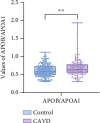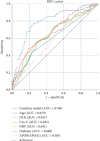Significance of APOB/APOA1 Ratio in the Prediction of Calcific Aortic Valve Disease
- PMID: 40787622
- PMCID: PMC12335912
- DOI: 10.1155/cdr/5528174
Significance of APOB/APOA1 Ratio in the Prediction of Calcific Aortic Valve Disease
Abstract
Background: Calcific aortic valve disease (CAVD) is a prevalent heart valve disease. The ratio of two apolipoproteins with distinct functions, Apolipoprotein B/Apolipoprotein A1 (APOB/APOA1), has been proposed as a novel assessment index for the evaluation of cardiovascular diseases. The aim of this article is to discuss the role of lipid parameters such as APOB/APOA1 in CAVD and the risk factors for CAVD, to develop a predictive model for CAVD, and to evaluate the sensitivity and specificity of this model. Method: Patients who initially presented to the Department of Cardiology of the Second Affiliated Hospital of Dalian Medical University between 1 January 2023 and 31 December 2023 were retrospectively identified and included in the study. Patients were divided into an aortic valve calcification group (111 cases) and a control group (201 cases) based on computed tomography (CT) findings. The clinical data, laboratory examination results, and chest CT images of the patients were collected and analyzed. A variety of statistical methods were used to analyze risk factors for CAVD, to construct a CAVD prediction model, and to assess its sensitivity and specificity. Results: Lipid parameters APOA1, APOB/APOA1, cumulative low-density lipoprotein (LDL) exposure, and non-high-density lipoprotein/high-density lipoprotein (non-HDL/HDL) were significantly associated with aortic valve calcification. Age, history of diabetes, diastolic blood pressure (DBP), APOB/APOA1, Cystatin C (Cys-c), and neutrophil-to-lymphocyte ratio (NLR) are identified as independent risk factors for CAVD, and the combined model achieved an AUC of 0.796 for CAVD prediction, corresponding to a sensitivity of 0.769 and a specificity of 0.755. Conclusion: The lipid parameters APOA1, APOB/APOA1, cumulative LDL exposure, and non-HDL/HDL have been demonstrated to be associated with aortic valve calcification. Furthermore, APOB/APOA1 can be used for the prediction of CAVD, and the combination of APOB/APOA1 with age, history of diabetes, DBP, Cys-c, and NLR has better prediction performance for CAVD.
Keywords: APOB/APOA1; calcific aortic valve disease; prediction model.
Copyright © 2025 Yuxing Wang et al. Cardiovascular Therapeutics published by John Wiley & Sons Ltd.
Conflict of interest statement
The authors declare no conflicts of interest.
Figures





Similar articles
-
Association of apolipoprotein B and apolipoprotein A1 levels with social determinants of health and coronary artery disease mortality in the United Kingdom Biobank - is there a need for consideration?Coron Artery Dis. 2024 Sep 1;35(6):509-515. doi: 10.1097/MCA.0000000000001380. Epub 2024 May 6. Coron Artery Dis. 2024. PMID: 38712680
-
Cardiovascular disease risk factors are associated with conventional lipids and apolipoproteins in South African adults of African ancestry.Lipids Health Dis. 2025 May 15;24(1):177. doi: 10.1186/s12944-025-02591-w. Lipids Health Dis. 2025. PMID: 40375303 Free PMC article.
-
Lipid metabolism disturbance and immune dysfunction in HBV-related acute-on-chronic liver failure: a retrospective cohort study.BMC Gastroenterol. 2025 Jul 1;25(1):444. doi: 10.1186/s12876-025-04004-9. BMC Gastroenterol. 2025. PMID: 40596946 Free PMC article.
-
Lipoprotein(a) and calcific aortic valve disease: current evidence and future directions.Curr Opin Clin Nutr Metab Care. 2024 Jan 1;27(1):77-86. doi: 10.1097/MCO.0000000000000976. Epub 2023 Aug 28. Curr Opin Clin Nutr Metab Care. 2024. PMID: 37650693 Review.
-
Valvular interstitial cells as a novel therapeutic target for preventing calcific aortic valve disease.Eur J Pharmacol. 2025 Sep 15;1003:177985. doi: 10.1016/j.ejphar.2025.177985. Epub 2025 Jul 22. Eur J Pharmacol. 2025. PMID: 40701265 Review.
References
MeSH terms
Substances
Supplementary concepts
LinkOut - more resources
Full Text Sources
Miscellaneous

